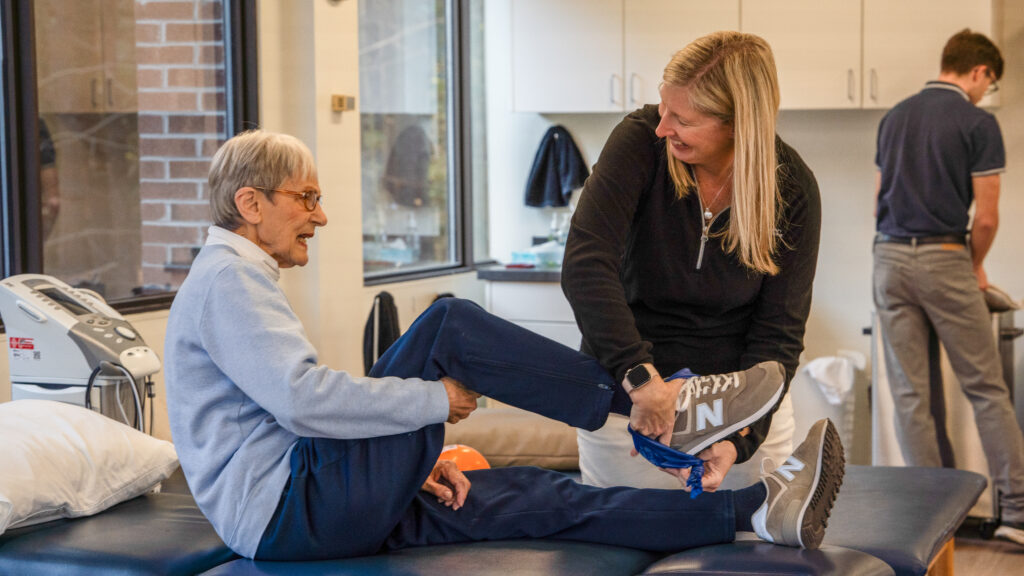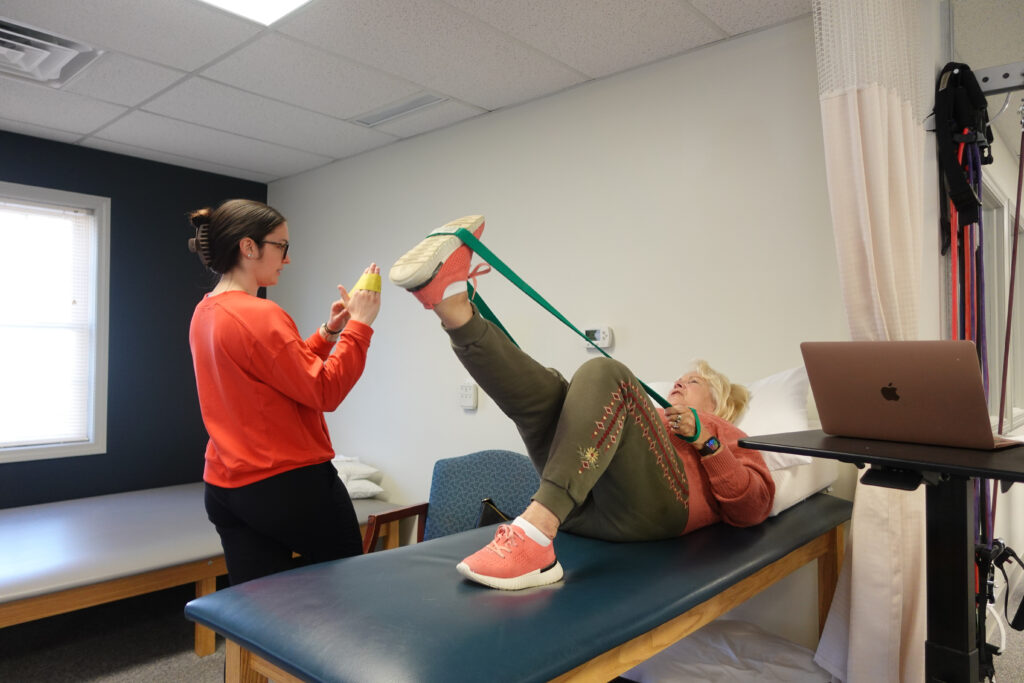Common Ankle Injuries: Physical Therapists Breakdown Goals and Techniques
with Jennifer Powers, Fairfield Physical Therapist

No matter the injury, there are two main goals of physical therapy: restoring mobility and restoring strength.
Although these are the two main goals, the physical therapist will also work to limit swelling (edema) and pain as the patient progresses through rehab. Some of the tools a physical therapist will use to accomplish this are:
- Game Ready Ice Machine – This is a system that provides cold therapy (cryotherapy) and compression at the same time. PTs will elevate the patient’s effected extremity to 45 degrees to further reduce swelling.
- HiVolt Electrical Stimulation – Combined with an ice pack and elevation, this works to decrease swelling and pain.
In order to restore mobility, some basic exercises a physical therapist will likely have the patient perform include:
- “Ankle Alphabet” – The patient goes through alphabet, performing the shape of each letter with their foot. Not only does this keep the ankle moving and decrease swelling, but it gives the physical therapist valuable insight into what parts of the foot or ankle are causing pain and/or stiffness. The therapist will observe which letters are challenging for the patient and make note of which muscles were being used to create those movements.
- Ankle Pumps and Ankle Circles – Simple strengthening exercises where the patient points and flexes their toes, and then moves their ankle in a circular motion.
- 4-Way Theraband Ankle Movements – Using a Theraband resistance band, the patient performs movements in all four directions (pointing toes, flexing toes, moving toes to the right, and moving toes to the left).
Patients often experience muscle loss in their calf muscles and decreased strength throughout the entire back side of the leg after an ankle injury, and especially after an Achilles tendon rupture. Some basic exercises a physical therapist will do to restore strength, especially in the back of the lower leg, include:
- Seated Calf Raises – A seated calf raise will target the soleus muscle. The patient can start without a kettlebell and then advance to using a kettlebell to add more weighted resistance once strength begins to improve.
- “BAPs Board” or Rocker-board – This is a wooden or plastic board that has an uneven surface on the bottom, so the patient must adjust their stance depending on the position. This strengthens the muscles that perform all actions of the ankle (pointing toes, flexing toes, inversion, and eversion). There are different difficulty levels that can be introduced as the patient progresses, and it can be performed with two legs or, for a greater challenge, standing on one leg.
- Leg Press – The patient will perform double or single leg press, focusing on flexing the toes and a static hold at the end range of the motion.
- Heel Raises/Toe Raises – The patient will perform heel raises to strengthen the muscles that point the toes and toes raises to strength the muscles that flex the toes.
- TRX Single Leg Squats – Using the TRX, a patient will perform single leg squats, which will help to reestablish single leg strength and balance, which are important components of running and walking, and vitally important in injury prevention in the future.

As the patient progresses through therapy, more treatments or modalities can be introduced to prepare the patient to return to daily life and physical activity. Whether the patient is an athlete or not, they need to be able to perform different functions with their ankle on uneven surfaces. One focus at this advanced point of therapy is restoring proprioception.
Proprioception is the body’s ability to sense its location, movements and actions without consciously thinking of our environment. For example, when out for a walk, you are likely not staring at the ground focusing on where you are stepping and consciously trying to step in certain spots while avoiding others. Proprioception is vital for balance and coordination while performing everyday movements.
Some tools a physical therapist will use to increase proprioception are:
- Agility Training with a Ladder
- Single Leg Hops
- Single Leg Balance
- Dynamic Heel Raises Across the Floor
- Bosu Ball Balance
- Bosu Ball Squats
Using unstable surfaces such as the Bosu, a foam pad, carpet, etc., challenges proprioception and mimics uneven terrain out in the community.
One more technique that a physical therapist may use to treat a patient with an ankle injury is Blood Flow Restriction training.
Blood Flow Restriction training involves partially restricting blood flow from a limb using an elastic band or cuff while performing specific exercises. This blockage deprives the muscle tissues of oxygen creating an environment similar to what muscles experience during a high-intensity workout. Patients are able to exercise at 30% of their maximum strength and still receive the same benefits, all while reducing the risk of reinjury.
Even if a patient is not able to bear weight on their ankle, they can still perform non-standing BFR movements and reap the benefits.
Ultimately the goals of physical therapy are to restore mobility, re-gain localized isolated muscular strength, progress strength and proprioceptive abilities once cleared for weight-bearing and return the patient back to the level of function they enjoyed before injury. Whether treating an ankle sprain or rehabbing a full ankle repair surgery, your physical therapist is here to help you stand confidently on solid ground again.
